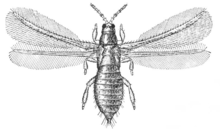| Thripidae | |
|---|---|

| |
| Pear thrips (Taeniothrips inconsequens) imago | |
| Scientific classification | |
| Domain: | Eukaryota |
| Kingdom: | Animalia |
| Phylum: | Arthropoda |
| Class: | Insecta |
| Order: | Thysanoptera |
| Suborder: | Terebrantia |
| Family: | Thripidae Stephens, 1829[1] |
| Diversity | |
| 4 subfamilies | |
The Thripidae are the most speciose family of thrips, with over 290 genera representing just over two thousand species.[2] They can be distinguished from other thrips by a saw-like ovipositor curving downwards, narrow wings with two veins, and antennae of six to ten antennomeres with stiletto-like forked sense cones on antennal segments III and IV.[3]
They are considered to be among the more derived of thrips, having evolved many traits key to specializing as cryptophilous phytovores, living in the narrow spaces at the bases of leaves and within flowers.[4][5]
Several species are economically significant pests, some of them invasive. Almost all of them are typical thrips which belong in the largest subfamily, the Thripinae.
- ^ Stephens, J.F. (1829). A systematic catalogue of British insects. London. p. 363.
- ^ Mound, L. A. 2002. So many thrips – so few tospoviruses?, pp. 15 - 18. In L. A. Mound and R. Marullo [eds.], Thrips and Tospoviruses: Proceedings of the 7th International Symposium on Thysanoptera. CSIRO Entomology, Reggio Calabria, Italy.
- ^ Mound, L. A. 1998. Thysanoptera: an identification guide. CAB International, Oxon, New York.
- ^ Gentile, A. G., and S. F. Bailey. 1968. A revision of the genus Thrips Linnaeus in the New World, with a catalogue of world species (Thysanoptera: Thripidae). University of California Press, Berkeley, CA.
- ^ Lewis, T. 1973. Thrips. Their biology, ecology and economic importance. Academic Press, London, GB.